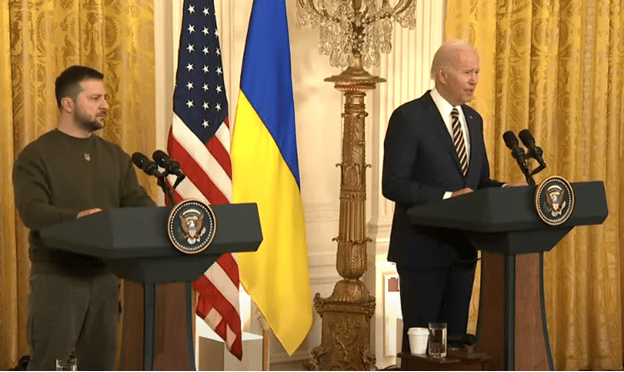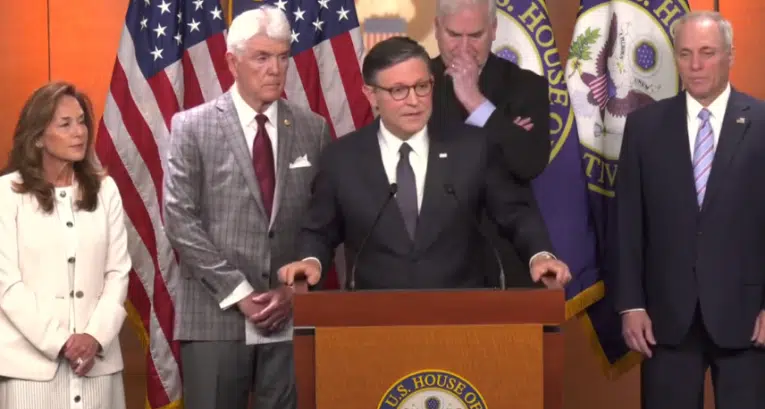
“I don’t think there is unanimity in NATO about whether or not to bring Ukraine into the NATO family now, at this moment, in the middle of a war.”
That was President Joe Biden in an exclusive interview with CNN on July 9, once again staking out the U.S. position on the prospects of Ukraine entering NATO following Russia’s invasion of that country beginning in Feb. 2022.
Biden explained, “For example, if you did that, then, you know – and I mean what I say – we’re determined to commit every inch of territory that is NATO territory. It’s a commitment that we’ve all made no matter what. If the war is going on, then we’re all in war. We’re at war with Russia, if that were the case.”
So, to avert war with Russia, which could go nuclear, the U.S. here has promised not to pursue NATO membership on behalf of Ukraine — for now.
In a Feb. 22, 2022 speech just prior to the invasion, Russian President Vladimir Putin said “Ukraine joining NATO is a direct threat to Russia’s security,” calling for a halt to any further NATO expansion and that NATO return to its 1997 borders, citing the threat of intermediate range nuclear weapons, once governed by the now-abandoned 1987 INF Treaty, being able to hit Russia.
Biden’s comments come a month after Ukrainian President Volodymyr Zelensky called NATO membership “impossible” while the war was ongoing, stating in June: “we are adequate people and understand that we will not pull any NATO country into a war… And that’s why we understand that we won’t be a member of NATO while this war is ongoing. Not because we don’t want to, because it’s impossible.”
For now, then, Russia has proven it is willing to go to war over Ukraine — it invaded — and NATO so far is saying it is not willing to go to war, and now Ukraine is saying it does not want to pull NATO into the war because of the consequences.
Under Article 5 of the NATO Treaty, it states, “The Parties agree that an armed attack against one or more of them in Europe or North America shall be considered an attack against them all and consequently they agree that, if such an armed attack occurs, each of them… will assist the Party or Parties so attacked…”
But to be added to the treaty alliance, adoption must be unanimous. Under Article 10 of the NATO Treaty, “The Parties may, by unanimous agreement, invite any other European State in a position to further the principles of this Treaty and to contribute to the security of the North Atlantic area to accede to this Treaty.”
In May 2022, both Finland and Sweden moved to become latest members of the military alliance, which has now been fully and unanimously approved by the NATO countries: by Canada, Iceland, Norway, Estonia, the UK, Albania, Denmark, Germany, Netherlands, Luxembourg, Bulgaria, Latvia, Slovenia, Croatia, Poland, Lithuania, Belgium, Romania, North Macedonia, Montenegro, France, Italy, the U.S., Czech Republic, Greece, Portugal, Spain, Slovakia, Turkey and Hungary, with Finland being included in April and Sweden this July.
Biden’s statement is actually not a surprise. When Ukraine requested fast track membership to accede to NATO in the fall of 2022, the U.S. immediately poured cold water on Kiev’s request to join the alliance with White House National Security Adviser Jake Sullivan telling reporters on Sept. 30, 2022: “the process in Brussels should be taken up at a different time.”
That is, “at a different time” when more than 20 percent of Ukraine’s territory is not compromised by Russia.
A good question might be whether the U.S. was aware of Zelensky’s intention to sign the application for joining NATO prior to him doing so.
Either way, Biden’s clarification definitely shows the limits of the West’s intent to escalate the conflict into a wider war.
As for U.S. involvement, if Ukraine were to join NATO, Congress would not even need to authorize the use of military force in order to get into a wider war. Instead, the consequential vote would be on adding Ukraine into NATO via a Senate vote. From there, the treaty would appear to be automatically be triggered and NATO would be at war with Russia.
That is, with no role in the process for the House of Representatives, even though the war-declaring power is a core Article I, Section 8 prerogative that is intended to avert this very dilemma. That is, all votes to insert America into a war must be done by the people’s representatives in both chambers of Congress, be presented to the President in the form of a bill and signed into law, or else the military action is not authorized.
There were a few authorizations to use military force in Ukraine in proposed in 2022, including a bill by former U.S. Rep. Adam Kinzinger (R-Ill.) that didn’t go anywhere. Perhaps that is for the best.
But in the nuclear age, given the mere seconds and minutes the allies would have to respond to a potential nuclear attack, an attack on one is an attack on all. Would Congress even have time to initiate a roll call?
That is the razor’s edge humanity has lived on since the end of World War II, with a technology so fearsome it can elude the niceties of our Constitution’s requirements of only ever going to war with the consent of the governed via the people’s representatives.
As it is, with the issue of Ukraine’s NATO accession settled for the time being, we still have one foot out the door when it comes to defending Ukraine, inviting the possibility of a very slowly drawn out conflict. If Ukraine will never be allowed to join NATO while Russia’s invasion is ongoing, why would Russia ever stop the war?
Robert Romano is the Vice President of Public Policy at Americans for Limited Government Foundation.





